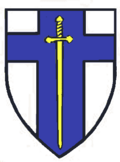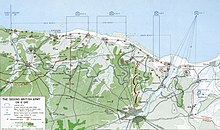Second Army (United Kingdom)
|
Second Army |
|
|---|---|
 badge |
|
| active | 1914-1918 1943-1945 |
| Country |
|
| Armed forces | United Kingdom Armed Forces |
| Armed forces |
|
| Type | army |
| Wars |
World War One World War II |
| Commander in chief | |
| list of | Commander in chief |
The Second Army ( German 2nd Army ) was a field army of the British Army , which was set up in the First and Second World War .
First World War
The army was formed on December 26, 1914 during the First World War when the British Expeditionary Force (BEF) was split up due to its size in order to better manage the troops. In Flanders, the 2nd Army almost continuously defended the frontal arc east of Ypres, threatened by the Germans, in several battles of Flanders until the end of the war .
1915
The first-appointed army leader General Horace Smith-Dorrien was replaced by General Herbert Plumer in May 1915 at the instigation of the commander-in-chief of the BEF John French after wrong decisions in the second Battle of Ypres .
In the Second Battle of Flanders (April 1915), the German army command used combat gas in the section for the first time , and the following corps units were subordinate to this:
- V. Corps (27th, 28th and 50th Divisions, 1st Canadian Division)
- II Corps ( 3rd and 5th Divisions)
- III. Corps (4th and 6th Divisions)
- Cavalry Corps (1st, 2nd and 3rd Cavalry Divisions)
In the course of the year the Canadian division also established itself in the area south of Ypres.
1917
On the morning of May 21, 1917, the 2nd Army opened the Battle of Messines by attacking the Wytschaete Arch . The German positions were fired at without interruption until June 7th at 2:50 a.m. The subsequent major British offensive began at 3:10 a.m. with the detonation of 19 mines , which created huge craters. On the northern section, the X Corps attacked under General Thomas Morland with the 23rd, 41st and 47th Divisions, behind them the 24th Division as a reserve. The main thrust in the middle was from the IX. Corps led by General Hamilton-Gordon with the 16th, 19th and 36th Divisions, the 11th Division was available in reserve behind them. In the south the II. ANZAC Corps under General Godley was assigned with the 25th Division on the left, the New Zealand Division in the middle and the 3rd Australian Division on the right. The 4th Australian Division formed the reserve behind it. The German group "Wytschaete" under General von Laffert was completely surprised, 7500 soldiers were taken prisoner, the remaining crews had to withdraw fighting.
The Third Battle of Flanders , which immediately followed , resulted in heavy losses on both sides. On July 31, 1917, after days of artillery bombardment, the major offensive began by the 5th Army with initially 18 divisions. The 2nd Army, which followed in the south, accompanied the attack with two divisions of its northern group (X and IX Corps), which attacked in the direction of Zandvoorde and Houthem against the German group Wytschaete ( IX Reserve Corps ) in the direction of Menin .
1918
Between November 1917 and March 1918, the Army High Command was transferred to the Piavefront in northern Italy to support the allied Italians . During this time the 4th Army was referred to as the 2nd Army . After returning to the Western Front , the army prevented the German breakthrough in the Battle of the Lys during the German spring offensive in April 1918 . During the Hundred Days Offensive in autumn 1918, the following corps groups were subordinate to the 2nd Army:
II Corps (Lieutenant General Claud Jacob )
- 9th Division (Major General Hugh Tudor)
- 34th Division (Major General Cecil Lothian Nicholson)
XIX. Corps (Lieutenant General Herbert Watts )
- 31st Division (Major General Campbell)
- 35th Division (Major General Arthur Henry Marinden)
- 41st Division (Major General Sidney TB Lawford)
X. Corps (Lieutenant General Reginald Byng Stephens)
- 29th Division (Major General Douglas Edward Cayley)
- 30th Division (Major General Weir de Lancey Williams)
XV. Corps (Lieutenant General Henry de Beauvoir de Lisle )
- 14th Division (Major General Percy Cyriac Burrell Skinner)
- 40th Division (Major General Peyton)
- 36th Division (Major-General Clifford Coffin)
Second World War
France 1944, Operation Overlord
During World War II, the field army was led by Lieutenant General Sir Miles Dempsey and was subordinate to the 21st Army Group . Two of their subordinate corps , the I. and XXX. , participated in Operation Neptune during Operation Overlord . Although the mission was a success, the terrain gains during D-Day fell short of the objectives. The VIII. Corps supplemented the fighting troops from June 1944. The goal of taking the strategically important city of Caen , however, could not be achieved in the first attempt. The 2nd Army carried out several offensives during the Battle of Caen ; At the end of June 1944, Caen was taken by the attackers.
US forces broke out of Normandy in late July . During their advance to the east, the German 7th Army was bound by the 2nd Army and trapped in the Falaise pocket. After the withdrawing German troops were largely wiped out, the army advanced with the US units on the right and the Canadians on the left through France towards the German Reich. The XII. Corps replaced the I. Corps, which in turn was subordinated to the Canadian 1st Army .
Belgium and Holland, Operation Market Garden
The Second Army quickly reached Belgium ; it liberated the capital Brussels (September 3rd), the important port of Antwerp (September 4th), Ghent (September 5th) and other parts of the country.
The second large-scale air-to-ground operation the British took part in was Operation Market Garden . British, Polish and American parachutists were dropped behind the German lines in order to get the strategically important bridges over several rivers and canals under control for the further rapid advance over the Rhine and the advance into the German Reich .
After the operation had largely failed, the 2nd Army spent the remainder of 1944 widening the gaps that had arisen in the German front lines. The final action took place in mid-January 1945 when the XII. and VIII Corps captured the triangular area between Roermond , Sittard and Heinsberg during Operation Blackcock . This enabled the subsequent advance to the Rur .
In February 1945 the advance of the Second Army came to a standstill; she fought all opposing German units. The 1st Canadian Army advanced further north ( Operation Veritable ); east of Aachen, the 9th US Army crossed the Rur in Operation Grenade .
German Empire 1945
On March 23, 1945, the 2nd Army crossed the Rhine during Operation Plunder and advanced towards the North German lowlands . On the left the Canadian 1st Army liberated the north of the Netherlands, while on the right the 9th US Army enclosed Army Group B under General Field Marshal Walter Model in the Ruhr basin . The encircled Army Group B tied the last large German armed force in the west and the end of the war had begun.
On April 4, 1945, the British units reached the Weser , the Elbe on April 19 and the Baltic coast near Lübeck on May 2. A day later, Hamburg surrendered and on May 7th, the British armed forces met the Red Army . Immediately afterwards the fighting ended with the German surrender by Colonel General Jodl and the High Command of the Wehrmacht .
Commander in chief
First World War:
- General Sir Horace Smith-Dorrien (1914-1915)
- General Sir Herbert Plumer (1915-1917)
- General Sir Henry Rawlinson (1917-1918)
- General Sir Herbert Plumer (1918)
Second World War:
- LtGen. Kenneth Arthur Noel Anderson (June 1943 to January 1944)
- LtGen. Miles Dempsey (January 1944 until the end of the war)
Web links
- British Second Army in France and Flanders 1914–1918 , "The Long, Long Trail"
- Battle of the Roermond Triangle, January 1945 (English)



